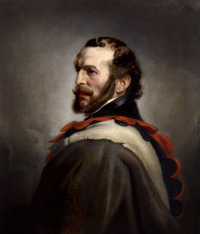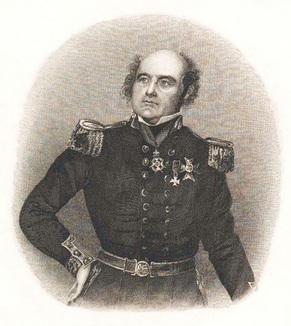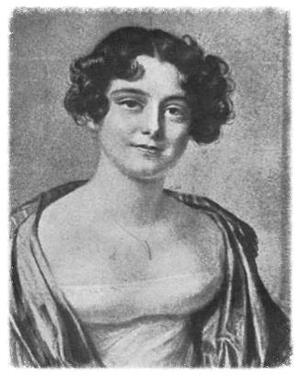 John Rae painted by Stephen Pearce 1862. Wikimedia Commons
John Rae painted by Stephen Pearce 1862. Wikimedia Commons Roger M McCoy
After serving my readers a heavy dose of Sir John Franklin’s disastrous first and third expeditions, we should have a look at an explorer who was thoroughly adept at surviving in the Arctic. Dr. John Rae became well-known for his remarkable feats of overland travel in the Arctic using skills learned from the local Inuit people. Chronologically this story of John Rae fits better between parts 2 and 3 of the Franklin account, so keep in mind that M’Clintock had not yet found their actual remains at the time of this account.
Rae was born in 1813 on the Orkney Islands off the north coast of Scotland—a chilly, wet environment that favors hardy souls. He graduated with a degree in medicine from the University of Edinburgh and became a member of the Royal College of Surgeons of Edinburgh. He soon went to Canada to work as a company doctor for the Hudson’s Bay Company at Moose Factory at the south end of Hudson Bay. During his ten year stay in Canada he traveled to various HBC trading posts treating ailments of company employees. In this time he became adept at travel under harsh Arctic conditions, a skill he learned from the indigenous people employed by the HBC.
The Hudson’s Bay Company wisely developed a practice of exploring and mapping the vast region extending roughly from Hudson Bay to the Rocky Mountains. They had a Royal Charter granted in 1670 by King Charles II giving them a monopoly on the fur and other resources. They could easily see their advantage in mapping coasts, rivers, and resources within their realm. To this purpose the HBC decided to send a surveyor well-suited to travel, map, and find resources in remote areas in the harshest conditions, and John Rae was the man.
First Rae had to learn how to survey, so he was directed in 1844 to go to the Red River Colony, about 700 miles to the west of Moose Factory. There he found the surveyor gravely ill and unable to teach. Rae then trekked east along the north shore of Lake Superior to Sault Saint Marie for instruction and and then on to Toronto for additional training. Most of this 2000 miles of travel was done by dog sled in winter. Then in 1846 he began his first surveying expedition on the north coast. By this time Rae was a well-seasoned and tested traveler and survivor in harsh conditions. Rae could build an igloo in an hour, eliminating the need for heavy canvas tents. He used clothing and bedding made of animal skins with the fur on the inside. The fundamentals were simple: keep clothing dry, learn to build snow houses, learn to hunt seals, wear clothing made of animal skins. Rae provided his Arctic survival knowledge to the Admiralty but it was ignored.
In 1853 while search parties were still looking for Sir John Franklin in other locations, John Rae went to explore and map the south end of the Gulf of Boothia. He approached from Repulse Bay at the north end of Hudson Bay and the following spring of 1854 crossed the isthmus of land now named for him. He continued across Boothia Peninsula, showing it to be a peninsula, and then crossed to King William Island, proving it was not connected to Boothia. By then Rae was somewhat east of the dead remains of the Franklin expedition. He met Eskimos who told him of thirty to forty white men who had starved to death several years earlier at a location farther west. Rae remarked that his knowledgeable informant wore a band around his head that came from the place of the dead men. Rae bought the Eskimo’s headband and told him he would also buy any other relics from the site of the dead men. Rae could not determine where the items came from or if the starved men had been part of the Franklin expedition. However he did not doubt that he had found the first clue to the Franklin party’s fate. Who else could it have been? Rae believed in the Eskimo’s truthfulness, having no reason to think the man would make up such a tale. He did not go to investigate the site himself because his first interest on this expedition was to continue mapping the Arctic coastline before winter began. He had made several important discoveries distinguishing between islands and peninsulas in the Boothia region, and was intent on finishing that job. He was, after all, a Hudson Bay Company employee and had been instructed to map rather than find Franklin.
In the autumn of 1854 he heard additional details about the Franklin party. Eskimos there told him that bodies had been found near the estuary of the Great Fish River. Given this information Rae was certain that the bodies were part of Franklin’s party. Furthermore the Inuits showed Rae more items found from the scene, including silver forks and spoons with crests of officers on Franklin’s ships. Other items included a plate with Franklin’s name, a gold watch, a vest, and numerous other items. The Eskimos could not say what happened to the ships, but their most surprising information was that the corpses’ bones had knife marks—definite signs of cannibalism. This was the first real information about the fate of the Franklin expedition, and Rae decided to travel to England immediately with the news.
In England his news was met with shock and disbelief. The relics he brought definitely proved that he had found news of Franklin, but no one believed that an Englishman would eat another Englishman. Everyone doubted Rae and thought he had been too gullible. Since they did not accept his story, the public made up an explanation that involved massacre by the Inuits. The alternative was simply too horrible to accept. Rae was further criticized for returning to England without first going to the site where the bodies were found. This criticism led to the accusation that he had been too eager to claim the £10,000 reward for finding evidence of Franklin. Public opinion ran high against Rae as the bearer of bad news and against the Inuits as murderous and barbaric people not to be believed.
Lady Jane Franklin held Rae in great contempt for his unbelievable story. She, like most of the public, disliked this “unrefined, coarse man” for standing by the Inuits’ story. Rae maintained they were telling the truth, but Lady Jane retorted that he had believed lies told by “savages.” In her outrage Lady Jane recruited important people for support, including none other than Charles Dickens who wrote several pamphlets condemning Rae for daring to say that British sailors could have resorted to cannibalism. She urged the Admiralty to delay the reward until further investigation by others. The Admiralty had doubts of their own about Rae’s credibility, and he was forced to appeal many times for the prize money, which he eventually received and distributed a fifth of it to members of his party. Other Arctic explorers were knighted for their work, some of whom made less significant contributions to the knowledge of the Arctic. Rae received the money, but no knighthood. It was Rae’s discoveries that convinced Lady Jane that further search should be made in the King William Island area, leading her to send M’Clintock to investigate (see, Sir John Franklin: The failed hero, Part 3, 10/1/15).
John Rae's accomplishments, surpassing all nineteenth-century Arctic explorers, were certainly worthy of honors and international fame. No explorer ever approached Rae's prolific record: 1,776 miles surveyed of uncharted territory; 6,555 miles hiked on snowshoes; and 6,700 miles navigated in small boats. Yet he was denied fair recognition for his discoveries because he dared to utter the truth about the fate of Sir John Franklin and his crew. A bitter smear campaign by Franklin's supporters denied Rae a knighthood and left him in ignominy for over 150 years. Finally some recognition came in 2014 when the British Parliament, urged by representatives from Orkney, announced that a plaque dedicated to John Rae would be installed in Westminster Abbey.
Sources
Berton, Pierre. The Arctic Grail: the Quest for the Northwest Passage and the North Pole, 1818-1909, New York:Viking Penguin, 1988.
McCoy, Roger M. On the Edge: Mapping North America’s Coasts. New York: Oxford University Press. 2012.
McGoogan, Ken. Fatal Passage: the True Story of John Rae, the Arctic Hero Time Forgot. New York: Carroll and Graf Publishers. 2002.
After serving my readers a heavy dose of Sir John Franklin’s disastrous first and third expeditions, we should have a look at an explorer who was thoroughly adept at surviving in the Arctic. Dr. John Rae became well-known for his remarkable feats of overland travel in the Arctic using skills learned from the local Inuit people. Chronologically this story of John Rae fits better between parts 2 and 3 of the Franklin account, so keep in mind that M’Clintock had not yet found their actual remains at the time of this account.
Rae was born in 1813 on the Orkney Islands off the north coast of Scotland—a chilly, wet environment that favors hardy souls. He graduated with a degree in medicine from the University of Edinburgh and became a member of the Royal College of Surgeons of Edinburgh. He soon went to Canada to work as a company doctor for the Hudson’s Bay Company at Moose Factory at the south end of Hudson Bay. During his ten year stay in Canada he traveled to various HBC trading posts treating ailments of company employees. In this time he became adept at travel under harsh Arctic conditions, a skill he learned from the indigenous people employed by the HBC.
The Hudson’s Bay Company wisely developed a practice of exploring and mapping the vast region extending roughly from Hudson Bay to the Rocky Mountains. They had a Royal Charter granted in 1670 by King Charles II giving them a monopoly on the fur and other resources. They could easily see their advantage in mapping coasts, rivers, and resources within their realm. To this purpose the HBC decided to send a surveyor well-suited to travel, map, and find resources in remote areas in the harshest conditions, and John Rae was the man.
First Rae had to learn how to survey, so he was directed in 1844 to go to the Red River Colony, about 700 miles to the west of Moose Factory. There he found the surveyor gravely ill and unable to teach. Rae then trekked east along the north shore of Lake Superior to Sault Saint Marie for instruction and and then on to Toronto for additional training. Most of this 2000 miles of travel was done by dog sled in winter. Then in 1846 he began his first surveying expedition on the north coast. By this time Rae was a well-seasoned and tested traveler and survivor in harsh conditions. Rae could build an igloo in an hour, eliminating the need for heavy canvas tents. He used clothing and bedding made of animal skins with the fur on the inside. The fundamentals were simple: keep clothing dry, learn to build snow houses, learn to hunt seals, wear clothing made of animal skins. Rae provided his Arctic survival knowledge to the Admiralty but it was ignored.
In 1853 while search parties were still looking for Sir John Franklin in other locations, John Rae went to explore and map the south end of the Gulf of Boothia. He approached from Repulse Bay at the north end of Hudson Bay and the following spring of 1854 crossed the isthmus of land now named for him. He continued across Boothia Peninsula, showing it to be a peninsula, and then crossed to King William Island, proving it was not connected to Boothia. By then Rae was somewhat east of the dead remains of the Franklin expedition. He met Eskimos who told him of thirty to forty white men who had starved to death several years earlier at a location farther west. Rae remarked that his knowledgeable informant wore a band around his head that came from the place of the dead men. Rae bought the Eskimo’s headband and told him he would also buy any other relics from the site of the dead men. Rae could not determine where the items came from or if the starved men had been part of the Franklin expedition. However he did not doubt that he had found the first clue to the Franklin party’s fate. Who else could it have been? Rae believed in the Eskimo’s truthfulness, having no reason to think the man would make up such a tale. He did not go to investigate the site himself because his first interest on this expedition was to continue mapping the Arctic coastline before winter began. He had made several important discoveries distinguishing between islands and peninsulas in the Boothia region, and was intent on finishing that job. He was, after all, a Hudson Bay Company employee and had been instructed to map rather than find Franklin.
In the autumn of 1854 he heard additional details about the Franklin party. Eskimos there told him that bodies had been found near the estuary of the Great Fish River. Given this information Rae was certain that the bodies were part of Franklin’s party. Furthermore the Inuits showed Rae more items found from the scene, including silver forks and spoons with crests of officers on Franklin’s ships. Other items included a plate with Franklin’s name, a gold watch, a vest, and numerous other items. The Eskimos could not say what happened to the ships, but their most surprising information was that the corpses’ bones had knife marks—definite signs of cannibalism. This was the first real information about the fate of the Franklin expedition, and Rae decided to travel to England immediately with the news.
In England his news was met with shock and disbelief. The relics he brought definitely proved that he had found news of Franklin, but no one believed that an Englishman would eat another Englishman. Everyone doubted Rae and thought he had been too gullible. Since they did not accept his story, the public made up an explanation that involved massacre by the Inuits. The alternative was simply too horrible to accept. Rae was further criticized for returning to England without first going to the site where the bodies were found. This criticism led to the accusation that he had been too eager to claim the £10,000 reward for finding evidence of Franklin. Public opinion ran high against Rae as the bearer of bad news and against the Inuits as murderous and barbaric people not to be believed.
Lady Jane Franklin held Rae in great contempt for his unbelievable story. She, like most of the public, disliked this “unrefined, coarse man” for standing by the Inuits’ story. Rae maintained they were telling the truth, but Lady Jane retorted that he had believed lies told by “savages.” In her outrage Lady Jane recruited important people for support, including none other than Charles Dickens who wrote several pamphlets condemning Rae for daring to say that British sailors could have resorted to cannibalism. She urged the Admiralty to delay the reward until further investigation by others. The Admiralty had doubts of their own about Rae’s credibility, and he was forced to appeal many times for the prize money, which he eventually received and distributed a fifth of it to members of his party. Other Arctic explorers were knighted for their work, some of whom made less significant contributions to the knowledge of the Arctic. Rae received the money, but no knighthood. It was Rae’s discoveries that convinced Lady Jane that further search should be made in the King William Island area, leading her to send M’Clintock to investigate (see, Sir John Franklin: The failed hero, Part 3, 10/1/15).
John Rae's accomplishments, surpassing all nineteenth-century Arctic explorers, were certainly worthy of honors and international fame. No explorer ever approached Rae's prolific record: 1,776 miles surveyed of uncharted territory; 6,555 miles hiked on snowshoes; and 6,700 miles navigated in small boats. Yet he was denied fair recognition for his discoveries because he dared to utter the truth about the fate of Sir John Franklin and his crew. A bitter smear campaign by Franklin's supporters denied Rae a knighthood and left him in ignominy for over 150 years. Finally some recognition came in 2014 when the British Parliament, urged by representatives from Orkney, announced that a plaque dedicated to John Rae would be installed in Westminster Abbey.
Sources
Berton, Pierre. The Arctic Grail: the Quest for the Northwest Passage and the North Pole, 1818-1909, New York:Viking Penguin, 1988.
McCoy, Roger M. On the Edge: Mapping North America’s Coasts. New York: Oxford University Press. 2012.
McGoogan, Ken. Fatal Passage: the True Story of John Rae, the Arctic Hero Time Forgot. New York: Carroll and Graf Publishers. 2002.


